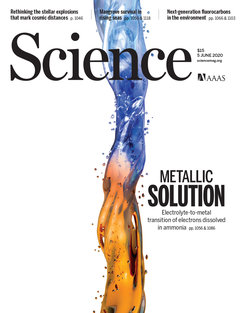Metallic ammonia? - Experiment shows for the first time how electrolytes become metallic

It is generally known that most metals conduct electricity. This is because some of the electrons in a so-called conduction band move unhindered through the crystalline lattice. This type of electrical conductivity is usually only found in metallic solids, while liquids, or more precisely electrolytes, often have a lower conductivity because positive and negative ions transport the electrical charges. In contrast to the movement of the free electrons in the metallic conduction band, however, the ions move through the liquid in a disordered and 'sluggish' manner. Researchers at the Fritz Haber Institute of the Max Planck Society have now investigated the mechanism behind the transition of an electrolytic liquid to a metallic electrolyte, which increases the electrical conductivity by orders of magnitude. How this transition occurs has been a largely unexplained question in fundamental research for more than 200 years. It is also a highly relevant question for 'large-scale industrial' battery and accumulator development or electrical engineering in general, since those industries are always looking for materials with different conductivities.
In cooperation with 15 researchers from renowned international institutes, the physicists Dr. Bernd Winter, Dr. Christian Schewe and PhD candidate Hebatallah Ali from the Department of Molecular Physics have devoted themselves to this question. In order to get answers, they studied electrolytes, i.e. chemical compounds that can conduct electricity, but not as well as metals. "We are interested in how many 'free' electrons have to be deposited in the electrolyte before metallic behavior can develop," explains Dr. Winter. "How much do we have to change the electrolytes until a conductive band forms?"
To answer this question, they first of all produced electrolytes from ammonia together with researchers from Prague and Los Angeles. Pure, liquid ammonia is (like pure water) an insulator and does not conduct electricity. Adding alkali metals such as lithium, sodium or potassium changes this, though. By doing this, one effectively adds moving charged particles to an insulating liquid, which, provided the concentration is sufficiently high, allows the formation of a conduction band. "The fact that ammonia is the basic material for the new electrolyte is, by the way, a nice historical coincidence," says a pleased Dr. Winter. "Our work has its origins in exactly the same place where Fritz Haber developed the industrial process for ammonia synthesis in the years 1905-1913.
The production of these ammonia electrolytes was, however, only possible with considerable technical effort and under many safety precautions. The biggest problem is that pure alkali metals in air react immediately with oxygen and water, which might not lead to an explosion but at least to a metal fire that can be several thousand degrees hot. "The crux of the whole experiment was to get a container free of water and oxygen and then stabilize it at temperatures between -40 °C and -75 °C, only then does ammonia condense. Only then can the alkali metals be added and dissolved in a controlled way via an evacuated access," said Schewe. The frozen ammonia was then installed together with a cooling unit (a so-called cryostat) in a vacuum measuring device at the Berlin synchrotron radiation source BESSY II. In this apparatus, the behaviour of electrons in the different electrolytes was measured by photoelectron spectroscopy on microjets (a very fine liquid beam of cold ammonia solutions with different concentrations of alkali metal) in high vacuum. "For the first time we were able to capture the photoelectron signal of 'free' excess electrons in liquid ammonia," the researchers explain.
Because the solutions absorb light in the red spectral range, they are weak blue at low concentrations (= only single dissolved electrons), and the blue colour intensifies with increasing concentration (bound pairs of two, so-called solvated electrons are formed). If the alkali metal concentration is further increased, the blue colour changes from a matt bronze to a golden hue. This impressive colour change is related to the transition from electrolyte to a liquid metallic solution. In the photoelectron spectra, it could be observed how gradually solvated electrons disappear when the alkali metal concentration is gradually increased, and how 'free' electrons appear instead, which finally form a metallic conduction band. This gradual transition from an electrolyte to a metal in these liquid alkali-metal-ammonia systems is extraordinary in that it is compared to the analogous transition from semiconductors to metallic conductors in solid state physics, where the transition usually happens abruptly.
The work makes an important contribution to the basic understanding of the transition from an electrically non-conducting liquid, pure ammonia, to an electrolyte which shows a certain electrical conductivity due to the solvated electrons, and finally to a metallic electrolyte which has a very high conductivity.












